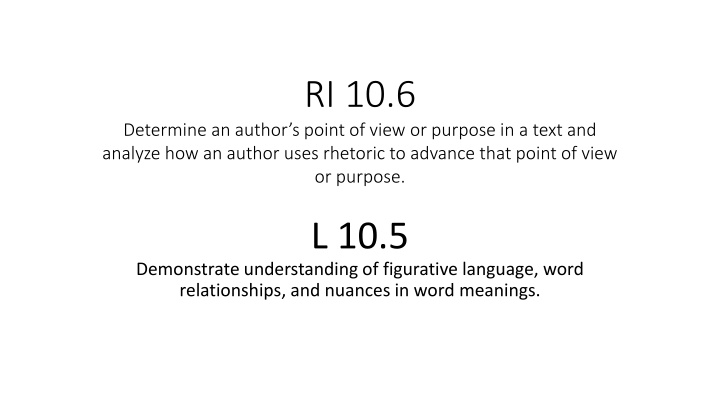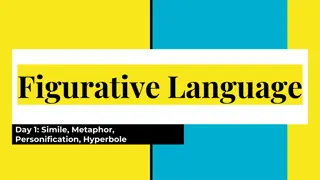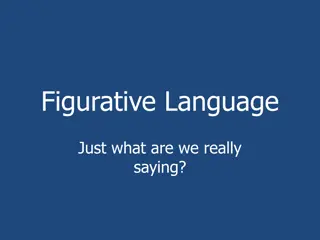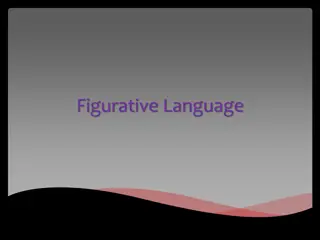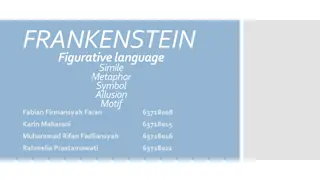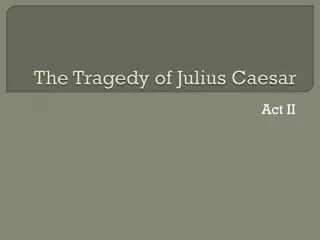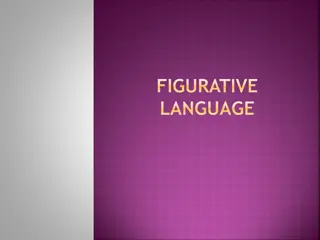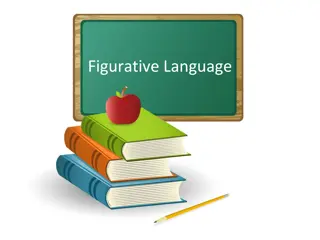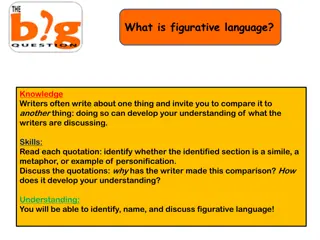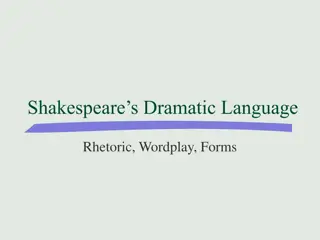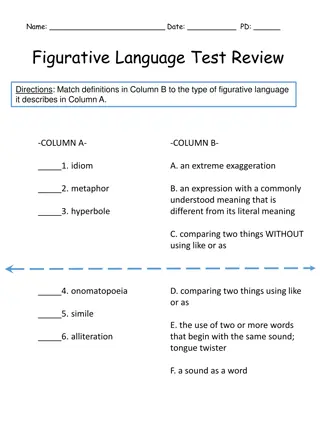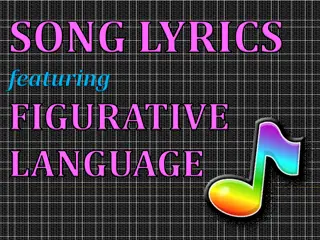Analyzing Author's Rhetoric in Figurative Language
Authors use figurative language like simile, metaphor, antithesis, anaphora, and rhetorical questions to convey deep meanings and evoke imagery in their writing. Understand the nuances of word relationships and the impact of rhetorical devices on conveying the author's point of view or purpose.
Download Presentation

Please find below an Image/Link to download the presentation.
The content on the website is provided AS IS for your information and personal use only. It may not be sold, licensed, or shared on other websites without obtaining consent from the author.If you encounter any issues during the download, it is possible that the publisher has removed the file from their server.
You are allowed to download the files provided on this website for personal or commercial use, subject to the condition that they are used lawfully. All files are the property of their respective owners.
The content on the website is provided AS IS for your information and personal use only. It may not be sold, licensed, or shared on other websites without obtaining consent from the author.
E N D
Presentation Transcript
RI 10.6 Determine an author s point of view or purpose in a text and analyze how an author uses rhetoric to advance that point of view or purpose. L 10.5 Demonstrate understanding of figurative language, word relationships, and nuances in word meanings.
Figurative Language L 10.5 Simile A simile is a device in which the writer compares two things that are unrelated, but through the simile, a relationship is made. Since similes conjure up strongly suggestive imagery, they lend new details to the main comparison and, in almost all cases, use the words like or as to draw those connections. Examples: You sing like a bird. Like a mad dog, the man was looking for a fight.
Figurative Language L 10.5 Metaphor A metaphor is similar to a simile in that they re both used to draw connections between dissimilar objects. In a metaphor, instead of saying that one thing is like another thing as you would with a simile, you treat one object as if it actually were another. A metaphor can be used poetically, but it can also create new ideas by focusing on emotional or psychological truths, rather than just the literal truths in a scenario Examples: John, a bear on the football field, never acted fierce otherwise. A teacher must plant the seeds of knowledge in his or her pupils.
Figurative Language L 10.5 Antithesis makes use of a contrast in language to bring out a contrast in ideas. Antithesis has a natural beauty to the human ear because we love to organize and categorize our thoughts and ideas. It can be built to point out fine distinctions in an issue by presenting them together, or it can be used to emphasize how different the two concepts are. Examples: To err is human, to forgive, divine. The poverty of the family alongside the wealth of the landlord helped the judge rule properly.
Figurative Language L 10.5 Anaphora is the deliberate repetition of a phrase at the beginning of multiple clauses or sentences to lend emphasis to a single idea. It is most commonly used to create a sense of climax, building from least important to most important and guiding an audience to a final strong conclusion. Examples: To everything there is a season, and a time to every purpose under heaven. A time to be born, a time to die, a time to plant, and a time to pluck up that which is planted; A time to kill, and a time to heal; a time to break down, and a time to build up... Give me liberty, or give me death.
Figurative Language L 10.5 Rhetorical Questions are questions asked by a speaker or writer that are not answered directly in the text, but which have an implied answer. It s an opportunity for the audience to fill in things that they already know, and for the reader to agree with the conclusion the writer expects. Examples: Should we just stand by and watch as children suffer? Do you want to be a millionaire in only one year?
Figurative Language L 10.5 Alliteration Alliteration is the repetition of a sound at the beginning of words to draw attention to a phrase and mark it as important. Examples: From forth the fatal loins of these two foes... My car was completely crushed.
Rhetorical Strategies RI 10.6 Women Ethos To look like Selena Gomez She has beautiful hair
Rhetorical Strategies RI 10.6 Everyone Pathos Reconnect with friends and share a memory We miss spending time with friends and this is how we can do it
Rhetorical Strategies RI 10.6 People with teeth Pathos/Logos Don t gamble with your teeth The teeth are dice. You are gambling with the health of your teeth if you don t use Crest.
Rhetorical Strategies RI 10.6 A rhetorical question is a question that is being asked solely for the purpose of making an argument instead of a genuine desire to hear the answer. Harlem by Langston Hughes makes excellent use of the rhetorical question: "What happens to a dream deferred? Does it dry up like a raisin in the sun? Or fester like a sore-And then run? Does it stink like rotten meat? Or crust and sugar over-like a syrupy sweet? Maybe it just sags like a heavy load. Or does it explode?"
Rhetorical Strategies RI 10.6 Martin Luther King s I Have a Dream Political speeches often use rhetoric to evoke emotional responses in the audience. One famous example would be Martin Luther King, Jr.'s I Have a Dream speech. "Let us not wallow in the valley of despair, I say to you today, my friends. And so even though we face the difficulties of today and tomorrow, I still have a dream. It is a dream deeply rooted in the American dream."
Rhetorical Strategies RI 10.6 Martin Luther King s I Have a Dream Martin Luther King Jr. s most famous and well known repetition was when he trumpeted, I have a dream 9 times in succession, each proclamation with a different topic following it but the same idea behind it. When he repeats this phrase it resounds like a heart beating. It is as if Dr. King is awakening the hope in his audience and throughout the country. It gives his audience a promise and ignites their faith when they hear that King has a dream. Each repetition stirs the hearts of those who hear him into peaceful endeavor for true freedom. Martin Luther King Jr. excites the long kindled fire within us into a roaring flame of hope and action.
